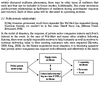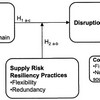 No, it’s not what you think it is, but I could not think of a more fitting title (to attract more readers), and had I been the author of this article, that’s the title I probably would have used when submitting my article, although I’m not sure the editor of the Journal of Supply Chain Management would have approved of it. More academically correctly titled, Triads in supply networks: Theorizing buyer-supplier-relationships by Thomas Y Choi and Zhaohui Wu is a fascinating read and a brilliant attempt at classifying buyer-supplier triads into nine distinctively different configurations.
No, it’s not what you think it is, but I could not think of a more fitting title (to attract more readers), and had I been the author of this article, that’s the title I probably would have used when submitting my article, although I’m not sure the editor of the Journal of Supply Chain Management would have approved of it. More academically correctly titled, Triads in supply networks: Theorizing buyer-supplier-relationships by Thomas Y Choi and Zhaohui Wu is a fascinating read and a brilliant attempt at classifying buyer-supplier triads into nine distinctively different configurations.
Ménage à trois
To set the record straight, the original French term “ménage à trois” means nothing more than simply “a household of three“, and the term “triad” means nothing more than simply “a group of three“. For some reason, however, what always comes to my mind when I hear the term triads is the term applied by British authorities to describe the various branches of underground society in Hong Kong, probably because that was my first acquaintance with the term, and it has stuck with me ever since.
From dyads to triads
The starting point for Choi and Wu is that much research in supply chain management has focused on dyadic relationships typically buyer-supplier, as all relationships in a network begin with a dyad. The truth is, however, so they say, that dyads do not capture the essence of a network. Their contention is that triads, not dyads, are the fundamental building blocks of a network.
Nine combinations
Although Choi and Wu do not refer to combinatorics in their paper, the law of permutations states that there are nine possible buyer-supplier-relationships in a triad that consists of one buyer and two suppliers. Choi and Wu use these nine combinations to propose a set of three states, with three possible configurations in each state:
- Balanced
- Unbalanced
- Structural Hole
I find this to be an incredibly simple yet at the same time incredibly refined model:

Balanced
A balanced state offers a stable relational structure for the firm members in the triad.
1 Balanced State 1: The buyer has a cooperative relationship with each supplier, and the suppliers have a cooperative relationship with each other. The buyer’s commitment to each supplier encourages the supplier to make asset-specific investments in the buyer’s business, and to engage in mutual collaboration for the greater benefit of all.
2 Balanced State 2: The buyer has an adversarial relationship with both suppliers, while the suppliers have a cooperative relationship with each other. In this case the suppliers work in a formal or non-formal alliance against the buyer.
3 Balanced State 3: The buyer has a cooperative relationship with one supplier, while having an adversarial relationship with the other supplier, while the two suppliers have an adversarial relationship. Contradictory as it may may seem, this is a balanced state with two negative and one positive relationship in the triad. For each of the three firms, the distinction between a friend and a foe is straight and clear.
Unbalanced
An unbalanced state reflects inequity and brings instability for organizational actors in the triad.
4 Unbalanced State 1: The buyer and each supplier have a cooperative relationship, while the suppliers have an adversarial relationship. For the buyer it may seem the perfect choice to work with competing suppliers, and suppliers aware of the competition may not wish to collaborate, since the other’s death means one’s own survival.
5 Unbalanced State 2: The buyer and one supplier and the two suppliers have a cooperative relationship, while the the buyer and the other supplier have an adversarial relationship. Interestingly, this may on one hand lead the “favored” supplier to gain more business from the buyer, on the other hand it may make this supplier more cautious, for fear of being treated in the same manner as the other supplier.
6 Unbalanced State 3: All three relationships are adversarial. This triadic relationship state is dysfunctional and transitory, and often accompanied by breakups and lawsuits.
Structural Hole
A triad with a structural hole is in fact very common in the business world. Here, the buyer maintains relationships with its suppliers, regardless of it being positive or negative, while there is no relationship between the suppliers.
7 Structural Hole 1: In this triad, the buyer sits on top of the structural hole between two suppliers and has a cooperative relationship with both suppliers. The buyer may actually play the role of an entrepreneur who spans across two suppliers without ties between them, thus acting as a middleman connecting these two in a business opportunity.
8 Structural Hole 2: In this case, the buyer has a cooperative relationship with one supplier but an adversarial relationship with the other. Here, the buyer can take advantage of the information asymmetry created by the structural hole…but only until one of the suppliers finds out.
9 Structural Hole 3: Here, the buyer has an adversarial relationship with both suppliers. often resulting in suppliers’ antagonism. A cunning buyer can actually play one supplier against the other.
Propositions
Embedded in each of the nine types are unique dynamic interactions among the buyer and its two suppliers. Choi and Wu formulate a number of propositions to describe the interactions and how they might play out over time:
Balanced State 1
The buyer’s ability to mediate relationships is an antecedent to establishing a balanced state with all positive relationships.
Balanced State 2
The realization by both suppliers of a negative relationship with the buyer leads them to develop a positive relationship.
Balanced State 3
If the buyer favors one supplier over the other, a negative relationship occurs between the two suppliers.
Unbalanced State 1
As long as the buyer successfully maintains positive relationships with both suppliers, the negative relationship between the suppliers tends to move toward a positive one.
If the negative relationship between the suppliers persists, then one of the existing positive relationships the buyer has with its suppliers may move toward a negative one.
Unbalanced State 1
If one supplier adheres to its negative relationship with the buyer and the other supplier sees more value in its positive relationship with the buyer, then the relationship between the suppliers tends to move toward a negative one.
If one supplier’s desire to grow the business overcomes its negative position toward the buyer, then the relationship between the buyer and this supplier tends to move toward a positive one as long as the other two relationships in the triad remain positive.
Unbalanced State 3
Without active intervention by the buyer to improve its negative relationship with both suppliers, both suppliers tend to develop a positive relationship to counterbalance their negative relationships with the buyer.
Structural Hole 1
When the buyer has a positive relationship with tow suppliers that are disconnected from each other, the buyer enjoys leverage power.
If the buyer were to bring otherwise disconnected suppliers together in a joint project, the buyer may lose some of the leverage power the suppliers would tend to develop a positive relationship on the strength of the buyer’s positive relationship with both of them.
Structural Hole 2
When the buyer has a positive relationship with one supplier and a negative one with the other supplier, the structural hole is less likely to be filled compared to the situation where the buyer has a positive relationship with both suppliers.
When the buyer positioned on a structural hole between two suppliers has a positive relationship with one and a negative relationship with the other, the buyer’s leverage power over its suppliers is minimized compared to when it has positive relationships with both suppliers.
Structural Hole 3
When the buyer has a negative relationship with both suppliers in the structural hole context, the buyer is weakest in its leverage power.
Both suppliers’ negative relationships with the buyer in are likely to trigger the formation of a positive relationship between the two suppliers.
I think the propositions excellently summarize the relational tendencies of the firms in buyer-supplier-supplier triads and how they operate dynamically and adapt to given relationship situations.
Conclusion
Buyer-supplier-relationships is not a topic that has received much attention on this blog so far, and only when I could relate it to supply chain risk, as in Cousins (2002) on why All firms are snakes or in Das and Teng (2001 ) on Trust, Control and Risk in Strategic Alliances. This article, however, has convinced that it is a matter I should look more in to. While the framework and nine archetypes may seem like an oversimplification, it has definitely triggered my interest in the subject, and added yet another research strand to my never-ending list of must-read articles.
Question
Can you relate to this framework and where do you stand in your relationships?
Reference
Choi, T., & Wu, Z. (2009). Triads in supply networks: Theorizing buyer-supplier-relationships. Journal of Supply Chain Management, 45 (1), 8-25 DOI: 10.1111/j.1745-493X.2009.03151.x
Author links
- asu.edu: Thomas Y Choi
- orst.edu: Zhaohui Wu
Related
- husdal.com: Why all firms are snakes
- husdal.com: Trust, Risk and Control in Strategic Alliances












